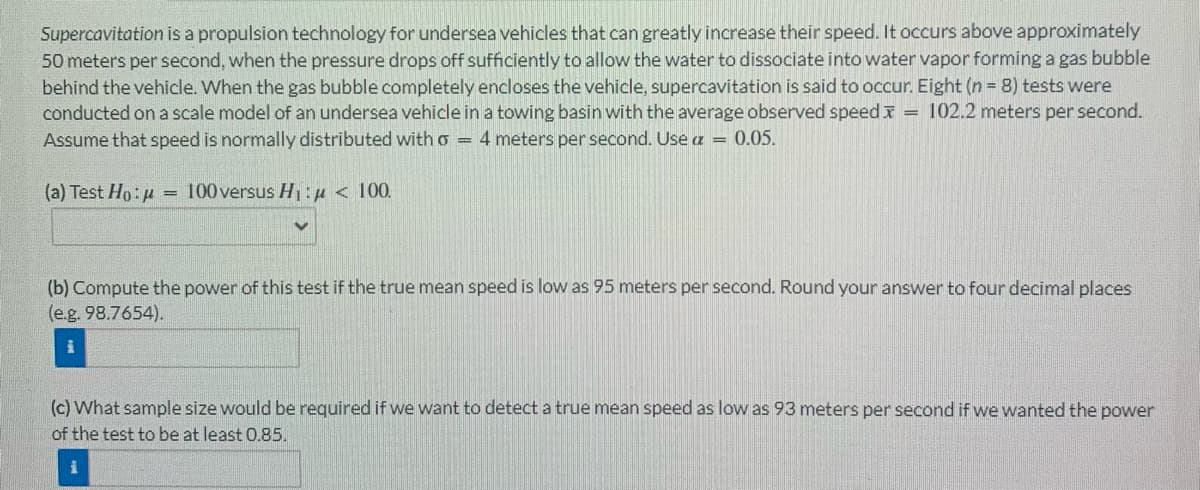Supercavitation is a propulsion technology for undersea vehicles that can greatly increase their speed. It occurs above approximately 50 meters per second, when the pressure drops off sufficiently to allow the water to dissociate into water vapor forming a gas bubble behind the vehicle. When the gas bubble completely encloses the vehicle, supercavitation is said to occur. Eight (n = 8) tests were conducted on a scale model of an undersea vehicle in a towing basin with the average observed speed = 102.2 meters per second. Assume that speed is normally distributed with o = 4 meters per second. Use a = 0.05. (a) Test Ho:μ = 100 versus H₁:μ < 100. (b) Compute the power of this test if the true mean speed is low as 95 meters per second. Round your answer to four decimal places (e.g. 98.7654). (c) What sample size would be required if we want to detect a true mean speed as low as 93 meters per second if we wanted the power of the test to be at least 0.85.
Supercavitation is a propulsion technology for undersea vehicles that can greatly increase their speed. It occurs above approximately 50 meters per second, when the pressure drops off sufficiently to allow the water to dissociate into water vapor forming a gas bubble behind the vehicle. When the gas bubble completely encloses the vehicle, supercavitation is said to occur. Eight (n = 8) tests were conducted on a scale model of an undersea vehicle in a towing basin with the average observed speed = 102.2 meters per second. Assume that speed is normally distributed with o = 4 meters per second. Use a = 0.05. (a) Test Ho:μ = 100 versus H₁:μ < 100. (b) Compute the power of this test if the true mean speed is low as 95 meters per second. Round your answer to four decimal places (e.g. 98.7654). (c) What sample size would be required if we want to detect a true mean speed as low as 93 meters per second if we wanted the power of the test to be at least 0.85.
Algebra & Trigonometry with Analytic Geometry
13th Edition
ISBN:9781133382119
Author:Swokowski
Publisher:Swokowski
Chapter7: Analytic Trigonometry
Section7.3: The Addition And Subtraction Formulas
Problem 76E
Related questions
Question

Transcribed Image Text:Supercavitation is a propulsion technology for undersea vehicles that can greatly increase their speed. It occurs above approximately
50 meters per second, when the pressure drops off sufficiently to allow the water to dissociate into water vapor forming a gas bubble
behind the vehicle. When the gas bubble completely encloses the vehicle, supercavitation is said to occur. Eight (n = 8) tests were
conducted on a scale model of an undersea vehicle in a towing basin with the average observed speed = 102.2 meters per second.
Assume that speed is normally distributed with 6 = 4 meters per second. Use a = 0.05.
(a) Test Ho:μ =
100 versus H₁:μ< 100.
(b) Compute the power of this test if the true mean speed is low as 95 meters per second. Round your answer to four decimal places
(e.g. 98.7654).
(c) What sample size would be required if we want to detect a true mean speed as low as 93 meters per second if we wanted the power
of the test to be at least 0.85.
i
Expert Solution
This question has been solved!
Explore an expertly crafted, step-by-step solution for a thorough understanding of key concepts.
This is a popular solution!
Trending now
This is a popular solution!
Step by step
Solved in 2 steps with 2 images

Recommended textbooks for you

Algebra & Trigonometry with Analytic Geometry
Algebra
ISBN:
9781133382119
Author:
Swokowski
Publisher:
Cengage

Mathematics For Machine Technology
Advanced Math
ISBN:
9781337798310
Author:
Peterson, John.
Publisher:
Cengage Learning,

Functions and Change: A Modeling Approach to Coll…
Algebra
ISBN:
9781337111348
Author:
Bruce Crauder, Benny Evans, Alan Noell
Publisher:
Cengage Learning

Algebra & Trigonometry with Analytic Geometry
Algebra
ISBN:
9781133382119
Author:
Swokowski
Publisher:
Cengage

Mathematics For Machine Technology
Advanced Math
ISBN:
9781337798310
Author:
Peterson, John.
Publisher:
Cengage Learning,

Functions and Change: A Modeling Approach to Coll…
Algebra
ISBN:
9781337111348
Author:
Bruce Crauder, Benny Evans, Alan Noell
Publisher:
Cengage Learning

Linear Algebra: A Modern Introduction
Algebra
ISBN:
9781285463247
Author:
David Poole
Publisher:
Cengage Learning